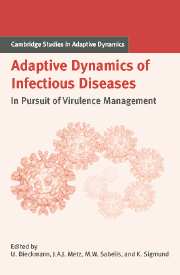Book contents
- Frontmatter
- Contents
- Contributing Authors
- List of Boxes
- Notational Standards
- 1 Introduction
- A Setting the Stage
- B Host Population Structure
- C Within-Host Interactions
- D Pathogen–Host Coevolution
- E Multilevel Selection
- Introduction to Part E
- 20 Weakened from Within: Intragenomic Conflict and Virulence
- 21 Ecology and Evolution of Chestnut Blight Fungus
- 22 Evolution of Exploitation and Defense in Tritrophic Interactions
- F Vaccines and Drugs
- G Perspectives for Virulence Management
- References
- Index
- International Institute for Applied Systems Analysis
20 - Weakened from Within: Intragenomic Conflict and Virulence
Published online by Cambridge University Press: 15 January 2010
- Frontmatter
- Contents
- Contributing Authors
- List of Boxes
- Notational Standards
- 1 Introduction
- A Setting the Stage
- B Host Population Structure
- C Within-Host Interactions
- D Pathogen–Host Coevolution
- E Multilevel Selection
- Introduction to Part E
- 20 Weakened from Within: Intragenomic Conflict and Virulence
- 21 Ecology and Evolution of Chestnut Blight Fungus
- 22 Evolution of Exploitation and Defense in Tritrophic Interactions
- F Vaccines and Drugs
- G Perspectives for Virulence Management
- References
- Index
- International Institute for Applied Systems Analysis
Summary
Introduction
Pathogen virulence is a product of selection that operates not only at the level of the pathogen, but also at those of the host and other interacting populations. For example, if a pathogen population within a host contains genetic variation for virulence, selection may favor the most virulent type. However, selection among infected hosts favors host individuals that resist pathogens virulent against other hosts. Once these resistant hosts have become more numerous, they effectively decrease the pathogen's virulence. The combined outcome in such a two-level selection system is likely to be some intermediate level of virulence (see Chapter 17). A more complex situation of multilevel selection involving three levels is discussed in Chapter 22.
In this chapter we focus on a special type of multilevel selection, in which natural selection operates simultaneously on several levels within an organism. Organisms can be viewed as nested hierarchies of replication levels. A multicellular organism contains cells; cells contain nuclei and mitochondria; nuclei contain chromosomes; chromosomes contain genes and noncoding sequences. Mitochondria also contain chromosomes, which contain genes. The important point is that replication takes place at all these levels. Moreover, all these structures possess heredity and may vary within the higher-level unit that contains them: an organism contains different cell types, and a cell may contain genetically different mitochondria. Thus natural selection may operate at many of these levels. A familiar example of multilevel selection within an organism is cancer.
- Type
- Chapter
- Information
- Adaptive Dynamics of Infectious DiseasesIn Pursuit of Virulence Management, pp. 280 - 285Publisher: Cambridge University PressPrint publication year: 2002



